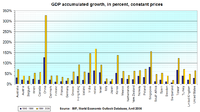
Photo from wikipedia
The relationship between the economy and the environment is not straightforward and is influenced by a multitude of factors. Ideally, economic growth would not damage environmental quality and environmental protection… Click to show full abstract
The relationship between the economy and the environment is not straightforward and is influenced by a multitude of factors. Ideally, economic growth would not damage environmental quality and environmental protection would not hinder economic growth. Achieving this decoupling often requires environmental policy, but the analysis of specific policy instruments and their necessary levels to achieve it is rare. In this paper, we use a stylized equilibrium model to explore distinct policy instruments under which relative decoupling and absolute decoupling between economic growth and emissions occur. In our model, final-goods production uses polluting (non-renewable) and non-polluting (renewable) resources. The government taxes emissions and subsidizes renewables production. In the empirical application, we focus on the case of electricity generation. Results show that, with a growing subsidy, relative decoupling exists. Achieving absolute decoupling is harder, but it occurs for a certain interval of the subsidy growth rate. For that purpose, the choice of the tax and subsidy growth rates is more important than the choice of the initial levels for these instruments. The choice of the subsidy growth rate indicates the prioritization between the economy and the environment. A lower subsidy growth rate favors the environment, while a higher one favors the economy. The tax growth rate dictates the distance between the output growth rate and the emissions growth rate. The higher the tax growth rate, the higher the difference between them. In sum, the government can decide between attaining higher output growth rates, higher emissions decreasing rates, or an intermediate situation.
Journal Title: Environment, Development and Sustainability
Year Published: 2020
Link to full text (if available)
Share on Social Media: Sign Up to like & get
recommendations!